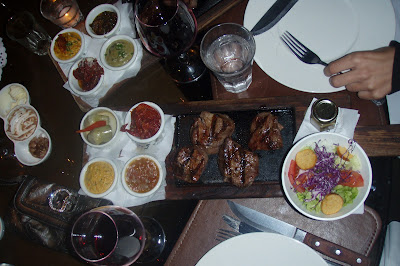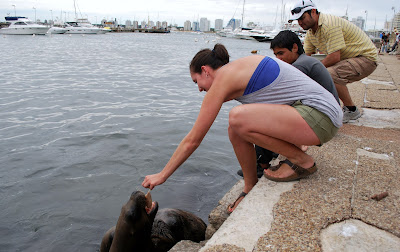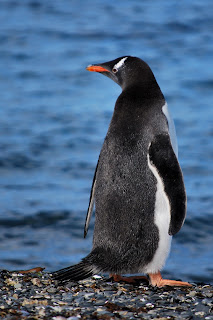We spent a night in Buenos Aires, left our big backpacks behind at the hostel, and headed to Uruguay for 4 days of sun and sand. We took the Buquebus ferry from Buenos Aires harbour to Colonia del Sacramento (“Colonia”), and spent a quiet day wandering around, eating gelato, and getting our blog posts up. Colonia was full of ancient (but running) vehicles, and scooters. We even saw a scooter with a child-seat mounted to the front! We ventured down to the beach for sunset, which was pretty, but decided to head further east for some sandier (and less polluted) beaches.
The following morning we took the bus from Colonia to Punta del Este via Montevideo. We decided not to spend any time in Montevideo because we were about to spend a week in a big city (Buenos Aires), and we were definitley ready for some beach time after all our adventures down south! We had been lucky to land reservations at the top-rated La Lomita del Chingolo guesthouse (a type of hostel) in “Punta” and were greeted with a kiss from Alejandra, our hostess. The small 12-bed hostel was run out of the home of a young couple, their 3-year old son (Agosto) and big chocolate lab. Incredibly laid back, full of character, and with a great atmosphere, this hostel was an absolute favourite of our trip. There was even an avocado tree in the backyard that produced gigantic avocados twice a year during avocado season. 
Not to mention La Lomita del Chingolo was one of the cheapest available in Punta (a pretty ritzy resort town), at $15. The population of Punta during the low season (mid-January to mid-December) is relatively small (7,300), but swells to more than 500,000 during the one-month peak season during the holidays. Luckily for us, we arrived just before peak season, which meant that the weather was perfect, but the prices were still low. Prices sky-rocket during peak season. For instance, a bed in our hostel on New Years eve sells for $400US (and it books up a year in advance)!! Punta is often nicknamed the "Monaco" of South America.
We headed to the beach on our first day, but only stayed for awhile, because the winds were high and we got a bit sandblasted. That night we all chipped in for groceries, and Alejandra & her husband (oops, we forget his name) cooked us a traditional Parrilla/Asado (BBQ) dinner in their backyard.
For $8 Canadian we had grilled provolone and baguette, vegetables and dip, chorizos, various cuts of steak, pork mambrillo (rolled stuffed pork), roasted vegetables, and salad. Parrilla is traditionally served on large, shared wooden platters, and the steak just kept coming (buffet style)! We ate way more steak that we should have (and normally could have), but it was so incredibly delicious we just kept eating! Lucky for us, there even cooked some of the steak rare, and it was the best rare steak we’ve ever had (we joked that it was like high-end steak “sushi”). Stuffed, and slightly disgusted with how much we ate, we finished eating around midnight (typical timing here) and hit the hay.

The following two days our schedule was pretty simple; breakfast, beach, make lunch, beach, gelato, wander, dinner, sleep, repeat. The (free) hostel breakfasts were laid-back, home-cooked, and incredible. She served us baked eggs with ham, home-made cereal, fresh-squeezed juice, fruit salad, tarts, cakes, teas, coffee, and grilled breakfast sandwiches.
There was a fancy grocery store in Punta, called Inglesa, that was beyond any other grocery store we’ve seen on our trip (and nicer that most grocery stores in Canada). It was practically a mall, and had everything imaginable. On our way back from the beach each day, we stopped to grab ingredients to make fresh salads and grilled seafood.
In the evening we wandered around Punta, down to the pier, where giant “Sea-wolves” lingered waiting for fish scraps. Despite their huge size, they were (mostly) quite friendly, and we even got to feed them. They took the fish scraps gently, just like a well-trained dog (a friendly local showed us how it was done).
After doing a little of our own research, we really aren't sure what these creatures are. They don't match the description for sea lions or elephant seals, but "Sea Wolf" doesn't turn up any results either. If you happen to know what these creatures are, please let us know!
Our hosts made us feel right at home, and even offered us rides around town (picking up their son from playschool along the way) and to the bus-station on our way back. We were free to use Alejandra’s well-equipped kitchen, and she even lent us towels for the beach.
Sadly, on our last day there, we mysteriously lost our “food bag”; a bag of self-catering necessities that we had been carrying around for months. Considering it was a mobile-kitchen, it was pretty well-equipped with oil, vinegar, seasonings, Tupperware, cutlery, tea, pasta, oatmeal, nuts and seeds and the like. We were certain it must have mistakenly been tossed out with the trash (it was just in a white plastic shopping bag) but after an embarrassing (and unsuccessful) dumpster-diving session we discovered that this wasn’t in fact it’s fate (unless a street-person found it first, which is a possibility).
We headed back to Buenos Aires that afternoon, and everything went very smoothly. We got the last two seats on our connecting bus, got on the last ferry, and basically walked right through customs and immigration. It was almost as if customs and immigration was more of a formality, rather than serving a purpose, because they barely looked at our passport, didn’t say two words, stamped it twice, and sent us on our way (no line or anything!).

















































